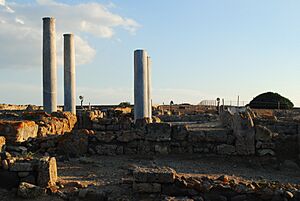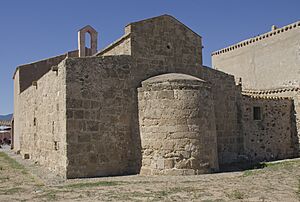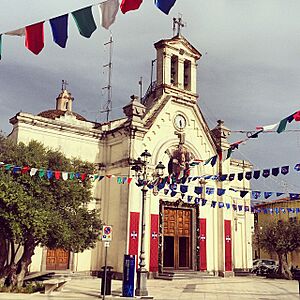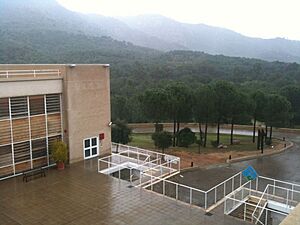Pula, Sardinia facts for kids
Quick facts for kids
Pula
|
|
|---|---|
| Comune di Pula | |
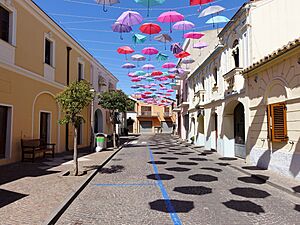 |
|
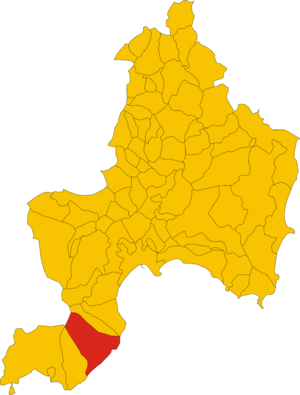 |
|
| Country | Italy |
| Region | Sardinia |
| Frazioni | Santa Margherita di Pula, Is Molas |
| Area | |
| • Total | 138.7 km2 (53.6 sq mi) |
| Elevation | 10 m (30 ft) |
| Population
(30 November 2017)
|
|
| • Total | 7,350 |
| • Density | 52.99/km2 (137.25/sq mi) |
| Demonym(s) | Pulesi |
| Time zone | UTC+1 (CET) |
| • Summer (DST) | UTC+2 (CEST) |
| Postal code |
09010
|
| Dialing code | 070 |
Pula is a lovely town in Sardinia, an island region of Italy. It's about 25 kilometers (15 miles) southwest of Cagliari, the main city. Pula is known for being a popular holiday spot with many hotels and beautiful beaches. It's also home to the amazing ancient ruins of Nora, which are some of the most important old sites on the island.
Contents
A Look at Pula's History
Pula is very close to the ancient city of Nora. Nora was built by the Phoenicians around 800 BC. Some clues suggest that Pula might have grown from an even older settlement built by the Nuragic people. Another story says that Iberians brought to Sardinia by a person named Norax founded it.
Rulers of Nora
Over the centuries, Nora was ruled by different groups. First, the Carthaginians took control. Then, the Romans came. For a short time, Nora was even the capital of the Roman area called Corsica and Sardinia. Later, the capital moved to nearby Caralis, which is modern-day Cagliari.
Nora's Decline and Pula's Rise
After the Western Roman Empire fell, Nora faced many attacks. Vandals and later Saracens raided the city. Because of these attacks, Nora slowly disappeared around the 8th century AD.
Modern Pula began in the Middle Ages. It was a village called Padulis de Nura, meaning "Nora Marsh." This village was part of the Giudicato of Cagliari, a local kingdom. In 1355, Pula became part of the lands owned by the Aragon family. It was then managed by different noble families.
Farming and Growth
In the 1700s, farming became very important again in Pula. Religious groups and the government helped improve the land for growing crops. This led to more olive trees and fruit being grown. This growth helped Pula develop into the town it is today.
Exploring Pula's Main Sights
Pula's Town Center
In the heart of Pula, you'll find the Giovanni Patroni Civic Museum. It's on Corso Vittorio Emanuele. This museum displays old items found during digs at Nora. The Church of San Giovanni Battista (St. John the Baptist) has two marble sarcophagi, which are like stone coffins. One holds the remains of a duchess who died in 1759. On Piazza del Popolo, there's Villa Santa Maria. This villa was designed in the early 1800s and built on the ruins of an old church.
The Ancient City of Nora
The ruins of the ancient city of Nora are located on the Capo di Pula promontory. These remains were found by accident. A big storm uncovered part of an old burial ground. More discoveries followed, including an amazing Roman theater. Today, this theater is sometimes used for concerts in the summer.
Nearby, a single column marks where a Roman temple once stood. Next to it is the forum, which was the main social and economic center of the city. There's also a temple dedicated to the goddess Tanit. A stone pyramid found there helped identify the goddess. Another large building seems to have been a spa complex. Its size shows it was a very impressive place.
Other Interesting Places
Just before the Nora site, you'll see the Church of Sant'Efisio, built in the 12th century. It stands where the saint was martyred. Below the church is Guventeddu beach, which means "small convent" in Sardinian.
The Center for Environmental Education is at the Lagoon of Nora. This aquarium has many sea creatures that live in the lagoon. After the lagoon, along the coast road, are the beaches of Punta d' Agumu and Foxi 'e Sali.
Santa Margherita di Pula is a tourist village and part of the Pula area. It grew around a church dedicated to a holy martyr. A large pine forest was planted there after World War II. This was part of projects to improve farming. Before 2020, the Forte Village Resort in the village hosted international tennis tournaments. Between Pula and Santa Margherita di Pula, you can find campgrounds at Cala d'Ostia. There are also long beaches with a marina at Cala Verde.
Culture and Learning in Pula
Pula is home to Polaris, the Science and Technology Park of Sardinia. This is a big research center that studies many different things. These include biomedicine, data analysis, energy, the environment, and how information affects society. With over 60 companies and research centers, Polaris is one of the largest science parks in Italy.
Pula also has several schools. These include the Alberghiera School, the Wiseword English School, and a Trinity Centre for international qualifications.
Images for kids
See also
 In Spanish: Pula (Italia) para niños
In Spanish: Pula (Italia) para niños


